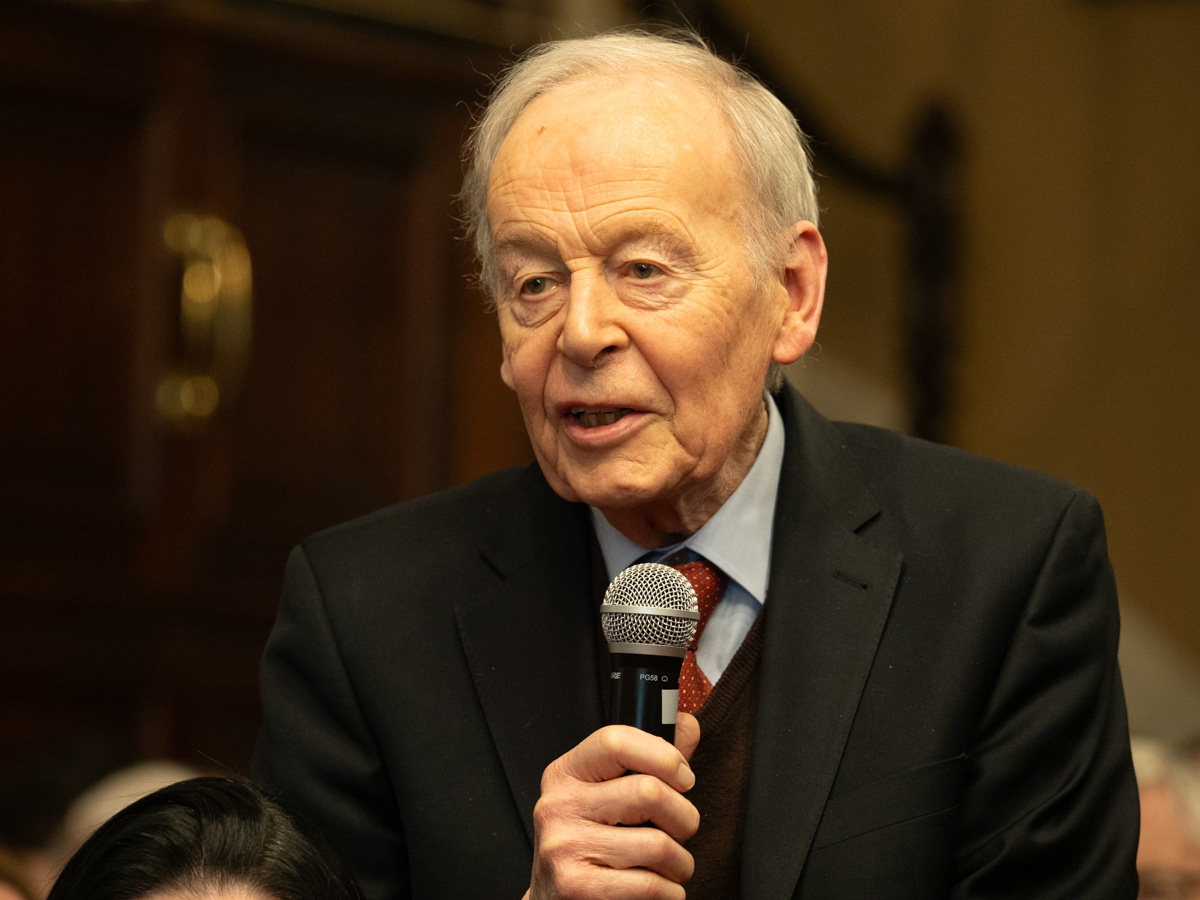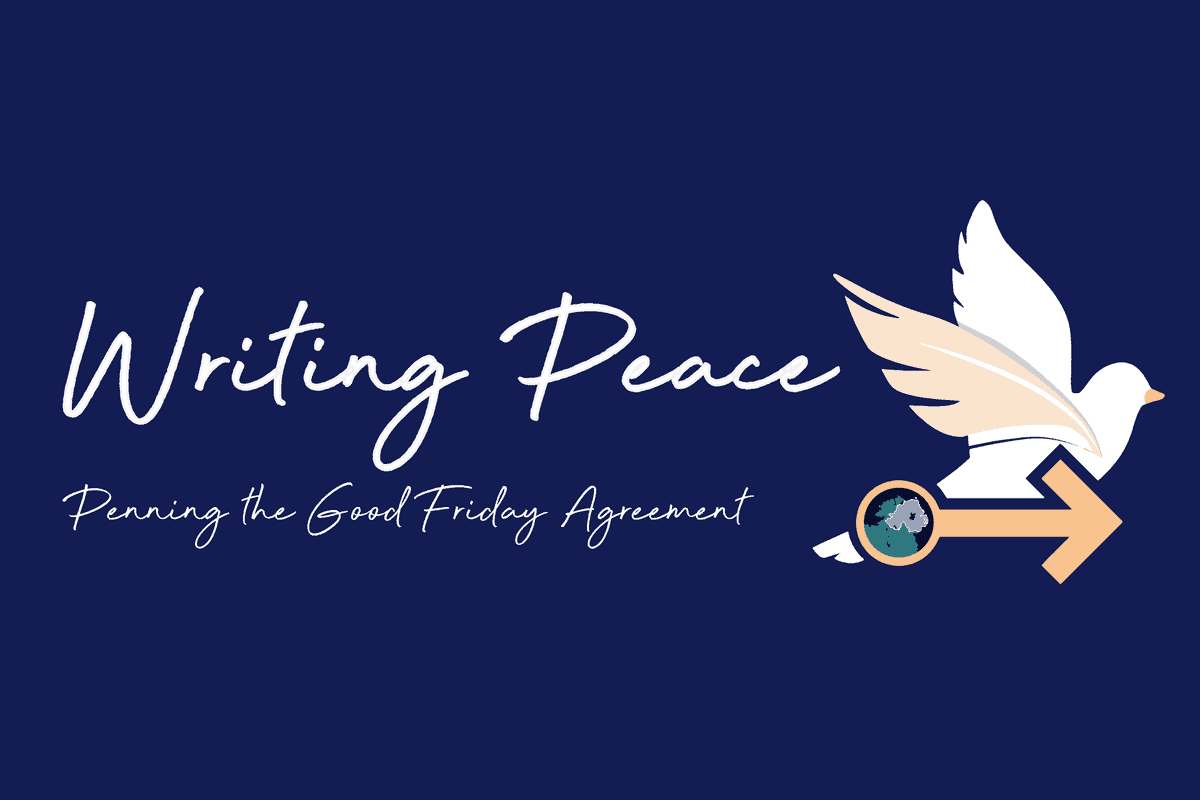The thirtieth anniversary of the Downing Street Declaration was marked by a panel discussion organised by ARINS (Analysing and Researching Ireland, North and South) and held at the Royal Irish Academy (RIA) in Dublin. RIA member Professor Katy Hayward chaired the conversation with Professor Ian McBride, Seán O’Huiginn, and Sir Jonathan Stephens. The event was in support of the Quill Projects at Pembroke College, Oxford; Writing Peace is bringing together archives, private papers, and oral histories from across the political spectrum to provide a fuller context of the Northern Ireland peace process.

Katy Hayward (Professor of Political Sociology at Queen’s University Belfast) welcomed the hundred-strong in attendance — peppered with negotiators past and present — and began by marking the significance of the joint declaration issued by the British and Irish Governments in Downing Street on 15 December 1993:
“It paved the way for a ceasefire and the entry of Sinn Féin into the peace talks. It also laid out a set of principles which, five years later, would come to underpin the [Belfast/Good Friday] Agreement.”
Hayward provided some context, such as U2, Take That, and Mr Blobby topping the charts in 1993; the year a Fianna Fáil–Labour coalition came together in Ireland; the forming of the UK Independence Party; and the first meeting of an Irish head of state (President Mary Robinson) with a British monarch (Queen Elizabeth). It was also the year of two of the worst atrocities of the Troubles: the Shankill Road bombing and the Greysteel Massacre.
She explained how the gestation for the declaration was long — several years — and that the final months of its completion were “somewhat tortuous and by no means certain”, with the final text negotiated line by line by the two Governments: “The joint declaration stands, both in content and presentation, as a mandate for the two governments to work together at every level.”

Ian McBride (Foster Professor of Irish History, Hertford College, Oxford) was introduced as someone “obsessed” with the Downing Street Declaration; he did not refute this. He began by suggesting that the best account of the origins of the peace process — focussing on the heroic work of intermediaries and on deliberations on clandestine bodies — was that by Niall Ó Dochartaigh.
But McBride added that messages passed along covert pipelines and then scrutinised by civil servants and paramilitary commanders deserve more of our attention, because this became part of a process of crafting words, creating a “linguistic space that the various protagonists in Northern Ireland could all inhabit and tolerate”.
McBride explored the “very slippery” ground of self-determination in Ireland:
“To most ears, this arcane phrase was merely a sophisticated way of saying ‘united Ireland’ or ‘Brits out’. But technically, the idea conferred legitimacy on any political structures for the island of Ireland approved by a majority of its inhabitants, voting in a single unit. There had not been an all-Ireland vote of this or any kind since the landslide victory of Sinn Féin in the general election of 1918 — a sanctified moment.”
McBride noted that there is always the problem of who the relevant “people” are as the political unit for self-determination. He elaborated on this later, citing John Major’s autobiography, where the former UK prime minister refers “three or four times” to Northern Ireland’s exclusive right to self-determination [e.g. p. 449]. McBride argued that that was “a mistake”: “If Northern Ireland [alone] had the right of self-determination, it would be able to declare itself independent [or] be integrated more fully into the United Kingdom [or] lose part of its territory if it wanted.” At the time, Seán O’Huiginn responded to a counterpart in the UK Government, John Chilcot, that “no, it’s not a good idea thinking of Northern Ireland as a self-determining unit”.
Indeed, this problem of “the people” was the primary one that the Downing Street Declaration attempted to solve. The relevant final draft text read:
“The British Government agree that it is for the people of the island of Ireland alone, by agreement between the two parts respectively, to exercise their right of self-determination on the basis of consent, freely and concurrently given, North and South, to bring about a united Ireland, if that is their wish.”
McBride thanked those working on the Quill Project and elaborated on its goal of creating a digital archive of the peace process:
“One can visualise source material and see context within which key decisions were made, trace origins of particular phrases, and identify priorities of individuals and political parties. The ambition is to create a model of the full process of negotiation and implementation of agreements between the late 1980s and the St Andrew’s Agreement of 2006, complete with educational tools for use in schools in Britain and Ireland.”
McBride cited this Writing Peace Quill Project with reference to Dermot Nally, who chaired the steering group behind the joint declaration and said that he’d never been involved in a negotiation where there were “so many fingers in the pie”; McBride said that this project “enables you to identify all of the fingers and attribute them to their respective bodies”:
“And you can see how the text was constructed in government buildings. In embassies. In hotel rooms of Heathrow. In paramilitary hangouts. In Brussels as well as in London and Dublin. In various Oxbridge colleges where the British and Irish Association met. In the café in the National Library of Ireland, where Martin Mansergh liked to meet Father Reid, or on Killiney Beach, where the two men walked way back at the very early stages of this story and discussed something that I think most sensible people believed was impossible in 1993 — their plan to bring about an IRA ceasefire.”

Seán O’Huiginn (former head of Anglo–Irish Division, Ireland Department of Foreign Affairs) spoke to the “theological”, or ideological, perspectives of Irish nationalist political parties:
“In dialogue with the SDLP, there was a clear shift, in [my perception], in the IRA attitude — it was no longer a fatwa that you had to take on faith… They had made the transition to feeling the need to justify their position through rational arguments. That, to me, was a psychological breakthrough.”
O’Huiginn said that it was in this background when it emerged from Father Reid and Gerry Adams (Sinn Féin president) that there was an expectation to get a positive declaration from the British Government regarding Irish sovereignty, and which could also be “a serviceable model for the Provisionals [IRA]”. He saw Sinn Féin as seeking “language on sovereignty”; he described a “floating process”, with regular tweaking of draft text in the joint declaration, as contributing to a basis for the IRA ceasefire.
O’Huiginn provided anecdotes of his diplomatic experience with two different UK Governments — under Prime Minister John Major and Prime Minister Tony Blair. What O’Huiginn described as a “destructive and negative force” of Sir Roderic Michael John Lyne — who wanted O’Huiginn wholly removed from the process — was contrasted with “constructive approaches [by other UK Government officials] in steering an imperfect peace — a peace infinitely better than the chaos and the murder that preceded it”. He also gave particular regard to former Taoiseach Albert Reynolds, who he described as someone he thought was “hugely conscious” of his duty to work for peace.

Sir Jonathan Stephens was private secretary to Northern Ireland Secretary of State Sir Patrick Mayhew and described himself as “a walk-on extra, a bag carrier”, in contrast to the “key players” on the panel and in the audience, citing Bertie Ahern, Martin Mansergh, Mark Durkan, and Noel Dorr, among others. Stephens recognised the roles played by key players on the UK side: John Chilcot (“who encouraged creativity and respect while having confidence and trust to allow others to shine”); David Cooke (“a master of drafting”); and Quentin Thomas (“a master of strategy and Seán O’Huiginn’s opposite number — a relationship half balletic dance, half gladiatorial combat, with words both as weapons and terms of endearment”).
Indeed, Stephens shared that O’Huiginn once told him, “Jonathan, Northern Ireland is both more simple and more complex than you’ll ever understand.”
In this regard, Stephens provided his analysis of the evolution of the peace process. As he saw it, the ongoing violence during the Troubles was contained but never acceptable. He explained that there were a series of attempts to address parts of the problem, but these had run into obstacles. But with Peter Brooke as Northern Ireland Secretary of State, Stephens argued, there was a “radical new approach” of an ambition to have a comprehensive framework of the totality of relationships — in Northern Ireland, the island of Ireland, and between the two islands — and seeking the most inclusive basis possible.
So, Stephens continued, the approach was to ensure that any political process had the broadest possible support:
“It was clear to us that [John] Hume and the SDLP would not participate unless this approach was undertaken seriously. So, the approach had to be explored until it either bore fruit or was shown in public to be fruitless (enabling progress to proceed without Sinn Féin).”
Stephens said that the resulting text of the joint declaration “married consent and self-determination so that, like the chicken and the egg, it becomes impossible to say which precedes which”: “As David Cooke put it, the two themes are intertwined in a double-helix of elegant complexity which provides the DNA running throughout the Declaration.”
For Stephens, there are two major lessons from the joint declaration process. The first is that on the central issue of the constitutional status of Northern Ireland, the Downing Street Declaration settled it so that the Belfast/Good Friday Agreement hardly needed to consider it “until the earthquake of the 2016 referendum [of UK membership of the EU] reopened it”.
The second lesson is that the joint declaration process still has critical applications for today:
“Frustrating as it is, it remains important to be comprehensive and inclusive in your approach. Attempts to solve one problem at a time, to address exclusive concerns of one side or another, are not sustainable and can lead to flip-flops. The two governments, working together, can still be a driver of agreement. They can identify and craft acceptable solutions which may be beyond what any one party puts forward… But neither the governments together, nor one on its own, can impose lasting solutions.
“Ultimately, the Downing Street Declaration proved of lasting value because its central principles were adopted by the parties and endorsed by the people. Approaches today which do not seek to engage and secure agreement across the parties, and ultimately garner widespread public support, will not succeed.”
Katy Hayward described one of her questions to the panellists as “nasty”: how much has Brexit damaged the relationship between the UK and Ireland Governments? Stephenson replied that he hoped the relationship was not in lasting trouble: “The earthquake of Brexit shook, but the foundation remains.” He added that ultimately we need to return to a comprehensive process, which he appeared optimistic about because of shared interests between the UK and Ireland.
PHOTOS




Peacebuilding a shared Northern Irish society ✌️ Editor 🔍 Writer ✏️ Photographer 📸 https://mrulster.com
Discover more from Slugger O'Toole
Subscribe to get the latest posts to your email.
